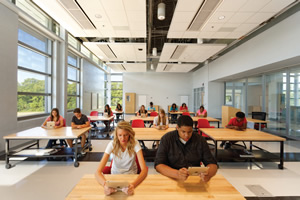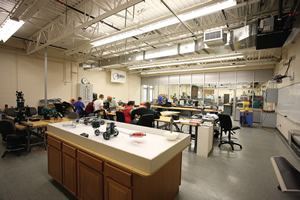Let There Be Better Light
- By Michael Fickes
- 02/01/15

PHOTOS COURTESY OF FANNING HOWEY
For a number of years, now, educators have known that proper lighting enhances student performance at all grade levels.
Today, lighting can do even more. Scientists now say that light — from the sun or a lamp — causes bodily responses. In fact, different qualities of light produce different responses.
The discovery makes it possible to change lighting in ways that enable students to perform better when engaged in different tasks — on tests, in class discussions, when reading and when collaborating with others on projects.
Light management has three parts — the level or brightness of light, the direction from which the light comes and the correlated color temperature (CCT) or Kelvin level.
By managing these lighting features, it is possible to establish and maintain the proper circadian rhythms for students as well as for faculty and staff.
Circadian rhythm, the human body’s internal clock, follows the Earth’s natural lighting cycle, writes Consultant Stan Walerczyk, CLEP, LC, in “Human Centric Lighting,” which appears his web site, www.humancentriclighting.com.
A principal with the Maui, Hawaii-based lighting consultant Lighting Wizards, Walerczyk writes, “…the Earth’s natural lighting cycle, which has low light levels and low correlated color temperatures in the early morning, high light levels and high CCTs at mid-day, low light levels and low CCTs during evening and extremely low light levels and a medium CCT under moonlight.”
This dynamic or changing light managed human wake and sleep cycles before we moved indoors and turned on artificial lights that wrench our circadian rhythms out of sync.
The three parts of light
Again, managing light involves managing intensity, direction and color.
Natural light from the sun changes intensity or levels dynamically throughout the day, moving from lower to higher intensity from morning to noon and higher intensity to lower intensity from afternoon through evening.
Light stimulates photoreceptors in the retina of the human eye. The more receptors stimulated, the greater the effect. Light radiating from above — as from the sun — activates the most photoreceptors. Inside, planar light from a large flat surface best recreates the way sunlight falls on people outside.
Then there is color temperature. The color temperature of light affects levels of chemicals in the body that change levels of alertness and the ability to focus on different kinds of tasks — test-taking, reading, participating in class discussions, collaborating on projects and working individually.
Walerczyk writes that the receptors “are especially responsive to light that is rich in blue content, the mid-day sky, for example, which can be up to 10,000K.” K stands for Kelvin, and 10,000K is an extremely high color temperature.
Blue, high Kelvin light excites photoreceptors, which in turn communicate with glands to suppress melatonin and produce dopamine, serotonin and cortisol. Melatonin puts us to sleep, while dopamine, serotonin and cortisol make us alert and productive.
How does this work in the classroom?
Researching light in the classroom
A number of studies have tested the idea of “tuning” classroom light to match the tasks at hand by adjusting lighting to affect mood, focus, motivation and concentration.
Lighting manufacturer Philips, the University of Mississippi and the University of Texas conducted a study called, “The Relationship of Dynamic Lighting and Oral Reading Fluency”, a few years ago.
That study followed 84 third grade students split into two classes. One class received what is defined as focus lighting, 6000K at 100 foot-candles. Normal lighting — a lower color temperature — illuminated the second class.
Michael S. Mott from the University of Mississippi and Daniel H. Robinson of the University of Texas authored the report on the study. Describing the results, they wrote: “Focus lighting led to a higher percentage increase in oral reading fluency performance (36 percent) than did control lighting (17 percent).”
The results of the study led Philips to develop its SchoolVision product. SchoolVision enables teachers to shift among four light level and color temperature settings. The four settings mimic the natural patterns of daylight. The settings are:
- Normal: Standard brightness and color tone sets the scene for the day’s lesson.
- Focus: Highest light intensity and a cool color tone help the kids concentrate during tests.
- Energy: This setting produces high intensity light with a very cool color tone to help students stay alert early in the morning and after lunch.
- Calm: Standard intensity level with a warm color tone can calm down a class that has grown hyperactive.
The government of Hamburg, Germany and the Universitatsklinikum Hamburg-Eppendorf conducted an independent test of SchoolVision.
Participants included 166 students and 18 teachers. The yearlong test showed that students studying under SchoolVision improved in concentration, attention span and behavior. Students also read faster and made fewer mistakes.
Some hard findings from the Hamburg study: Reading speeds increased an average of 35 percent. Errors decreased by 45 percent. Hyperactive behavior declined by 76 percent.

PHOTOS COURTESY OF FANNING HOWEY
Designing and retrofitting lights today and tomorrow
The arrival of LED lighting is making it easier and less costly to tune light in the classroom. “There is an extra cost of about $50 for dimming fluorescent ballasts,” says Rand Gulvas, PE, LEED AP, electrical discipline director for Fanning Howey, an architectural firm specializing in educational buildings.”
“LED manufacturers say that the additional charge for dimming will at most come to $10 and may be nothing,” says Gulvas. “We don’t, however, plan to incorporate color temperature into our designs until the industry standardizes the idea. That may take two to five years.”
In the meantime, Fanning Howey is designing new and retrofitting older lighting systems with LED lamps. “Today, LED lamps look like old conventional light bulbs but use 10 times less energy,” says Gulvas. “You can get them with warmer color temperatures like the orange tones produced by the old incandescent.”
LED lamps can also replace compact fluorescent lamps, which contain mercury and so create environmental disposal issues, continues Gulvas.
Retrofits also reduce the wattages of lamps, typically from 40 watts to 32 or 28 watts, and replace old ballasts with new electronic ballasts. “During a retrofit, we also clean the lenses and the interior of the fixtures,” adds Gulvas. “An old, dirty color degraded fixture can waste as much as 20 percent of the light. The technical term for that is Luminaire Dirt Depreciation or LDD.
“Another term is Lamp Lumen Depreciation or LLD. A fluorescent lamp might initially put out 3,000 lumens. After 24,000 hours, it will produce only about 1,500 lumens, half of the original brightness. As lamps age, they produce less light.
“Couple the two concepts — LDD and LLD — a dirty lens and fixture plus an old lamp and you will get significantly less light for the same amount of energy used.”
Gulvas goes on to say that it often makes more sense to replace the fixtures than to pay for the labor to take them apart, clean them and reassemble.
Gulvas doesn’t recommend LED lighting for all lighting yet, because the fixtures still carry a premium cost. “We always use LED fixtures in parking lots, gymnasiums and other spaces with high fixtures. The LEDs last twice as long as fluorescents and that saves on maintenance and replacement costs. In addition, the high bay fixtures have come down in price from $1,200 to $600.”
LEDs throughout
Two years ago, Princeton Middle/High School (grades 6-12) near Cincinnati, Ohio, decided to go all in for LEDs from high bay spaces to classrooms. The decision-makers understood that payback from savings on energy would take six years because of the premium cost of LED lamps and fixtures.
The decision added a $1 million premium to the cost of the school, less than 1 percent of the 550,000-square-foot project’s total $107 million cost.
“That was two years ago,” Gulvas says. “Today, the additional cost would be about $500,000.
“So we’re still not really at a price point where it makes sense for everyone to switch. But prices are dropping, and I think that in two to two-and-one-half years it will be worth it to switch completely to LED.
“Meanwhile, we’re telling facility managers that if they have some extra money in the budget, go with LED. If not, then try to economize with fluorescent lighting.”
By the time LED prices fall in line with fluorescent prices, the lighting industry will likely also be producing variable lighting systems that will enable teachers to vary the lighting throughout the day to wake students up and help them perform their best on tests, class discussions, collaborating on projects and other tasks.
So school lighting isn’t what it used to be. It has changed rapidly and dramatically in recent years. Over the next couple of years, it will change rapidly and dramatically again in ways that will help students perform better.
This article originally appeared in the issue of .